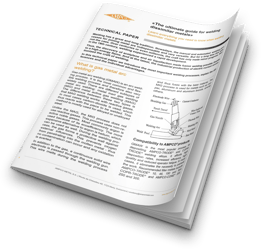When welding copper alloys, you have to choose the right welding process. This can be a challenging task. In order to bring some light into the darkness and help you make the correct decision, we give you an understanding of shield metal arc welding and flux-cored arc welding.
Welding is a handcraft with a great and millennial old tradition. Yet, in this blog post we shed a light on two welding processes that are rather young. Nevertheless, they are among the most common welding processes. This is because they don't require much equipement and hence are very portable. Therefore, these two methods can also be used outdoors.
What is SMAW?
The shielded metal arc welding (SMAW) is a manual arc welding process that uses a consumable electrode. It is also known as manual metal arc welding. The quality of the end product is greatly influenced by the skill of the operator and depends on how he positions and moves the electrode. The characteristic feature of this process involves an arc that burns between a manually guided stick electrode and the workpiece. A consumable electrode is used, that melts away during welding.
This consumable electrode has another characteristic typical for shielded metal arc welding: it contains flux material, which is responsible for the protective function by forming inert gases and a slag that protects the melt from chemical reactions with the ambient air. The layer of slag can be removed after it solidifies.

What are the advantages of SMAW?
The big advantages of this process lies in the flux material that is inside the consumable electrode. Because of this, no large equipment, like a separate gas tank, is needed. This makes the shielded metal arc welding the most portable of all welding processes. Therefore, it can be used in a wide range of environments including outdoors, in fabrication shops, on pipelines and refineries, on ships and bridges, among others.
What is FCAW?
Flux-cored arc welding (FCAW) was actually developed in the 1950s as an alterative to shielded metal arc welding. Unlike SMAW, which is operated manually, FCAW is either semi- or fully automatic. In this welding process a continuously fed consumable tubular electrode is used. There are two different processes to be distinguished.
In the first process, there is no need for an external shielding gas, since the electrode already comprises of flux material which protects the molten metal in the weld. Since the flux material is part of the electrode, this process is called the self-shielded process. The second process is called gas shielded process. Here, an additional shielding gas protects the molten metal from oxidation.
.jpg?width=361&name=FCAW_Process_v2%20(1).jpg)
What are the advantages of FCAW?
There are different advantages of the flux-cored arc welding process. First of all, it yields a high quality and consistent welds with fewer defects. Another big plus is that with the right filler metal, it can be performed in all welding positions. And lastly, just as the SMAW, it is suitable for outdoor welding as well as shop welding.
When to use SMAW or FCAW
Since the process of SMAW is portable and the equipment necessary is commonly available, it is a first choice for many welders involved with maintenance and repair applications. Nevertheless, a good preparation of the base metal is key. To obtain best weld results, you have to clean the surface beforehand and chose the perfect filler metal. For this process AMPCO-TRODE® 10, 46 and 150 as well as AMPCO-CORE® 200, 250 and 300 are very well suited.
Since the FCAW can also be performed outdoors, it is widely used in the marine industry – for example to repair ships. For FCAW we recommend the following filler metals: AMPCO-CORE® 200, 250, 250s and 300.
If you want to know more about the different welding processes and gain a deeper insight into the world of welding, download our free Technical Paper «The ultimate guide for welding dissimilar metals».





